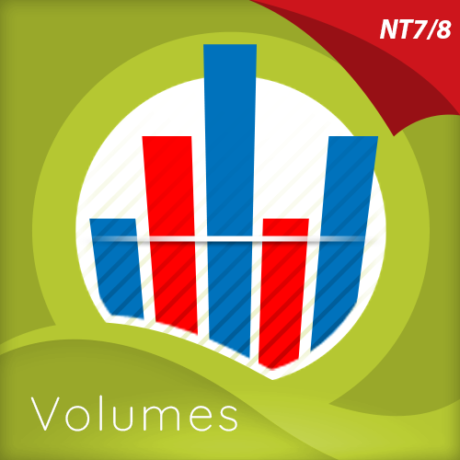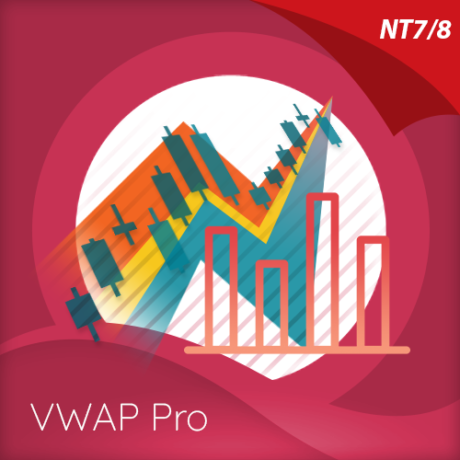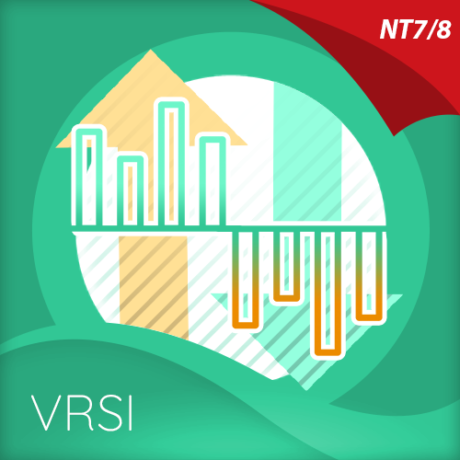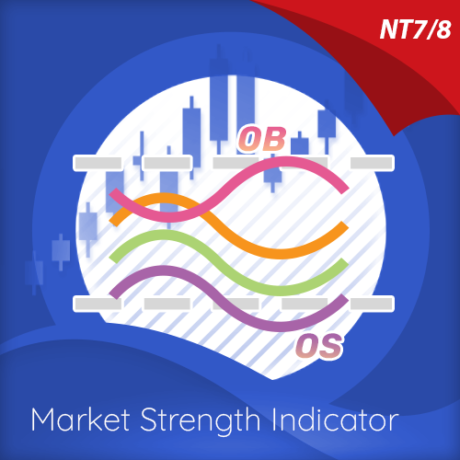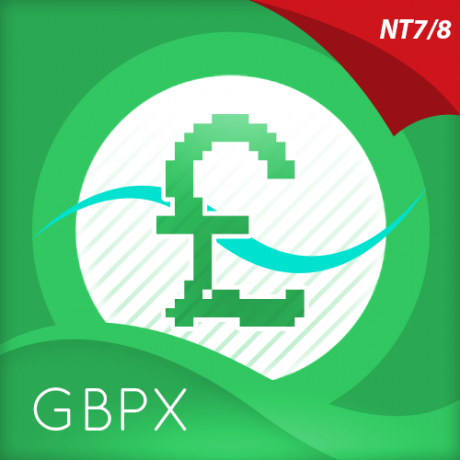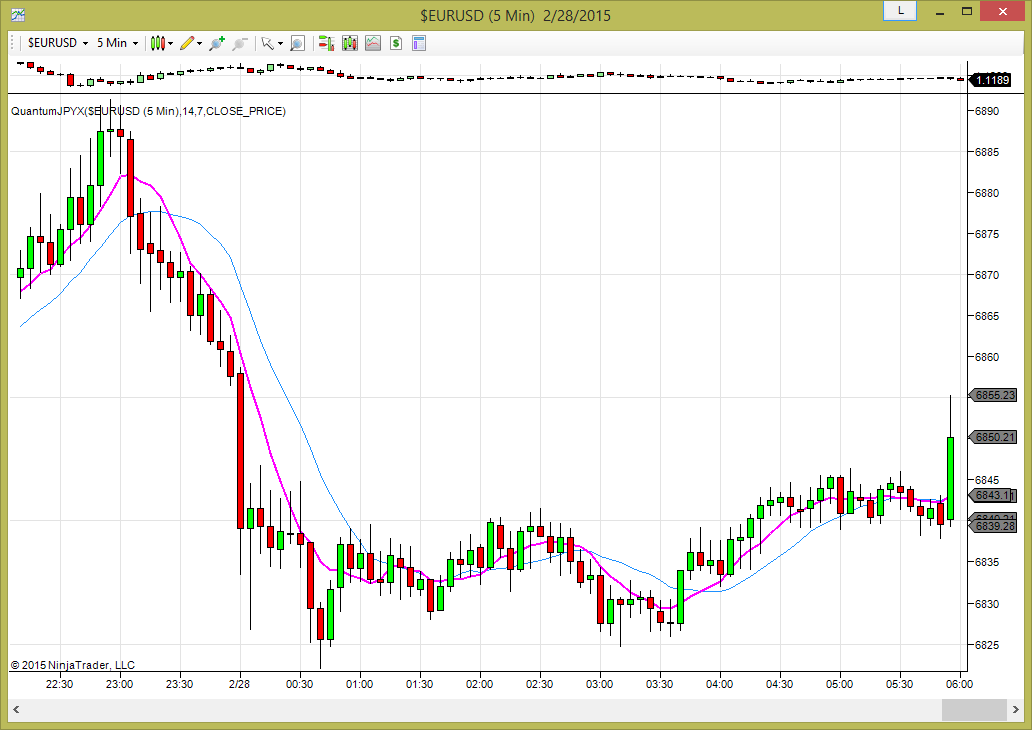
General – getting started
Many forex traders have either been told, or have learnt from painful experience, that the yen currency pairs can be both dangerous and volatile to trade. The GBP/JPY is perhaps the most infamous and volatile of all. No wonder then, that many forex traders simply stay away from the yen currency pairs. But then they probably don’t have a very clear idea of where the yen itself is heading. If they did, then trading the yen pairs would be much more straightforward. And even if you are trading other markets, such as index futures or stocks, having a view of the Japanese yen is crucial, given its characteristic of being a safe haven currency.
And this is where the Quantum JPYX indicator steps in. It has been designed to give you the ‘heads up’ on where the Japanese yen is heading next, against a basket of four currencies. The index is then constructed using an equal weighting of 25% as follows:
- Euro
- US Dollar
- Australian Dollar
- New Zealand Dollar
The indicator can be used in one of three ways:
- First, to identify and confirm strength and weakness in major and cross currency yen pairs, helping you get in, stay in and get out
- Second, as a confirming indicator for the Quantum Currency Strength indicator, providing a perspective against other currencies
- Finally, as a barometer of risk particularly when viewed through the prism of related markets, such as equities
Best of all, you can simply attach to the bottom of your chart, and never have to leave your NinjaTrader account. The indicator plots strength or weakness in the yen as a candlestick chart, supported by two simple moving averages.
For an even more forensic view of the yen, why not combine it with the Quantum Currency Strength indicator. Now you can trade the yen currency pairs with complete confidence, growing your trading account quickly, but with confidence!
Installation
Open your NinjaTrader platform and select a chart. We recommend that you choose a fast loading chart such as a spot major currency pair.
- Right click
This will open the following window
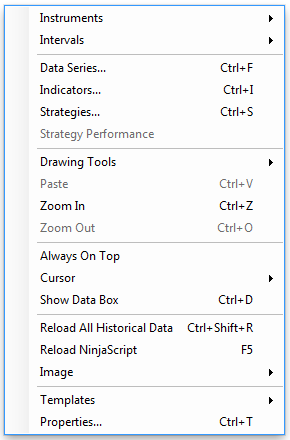
- Left click > Indicators
This will open the following window: (you can also open this window in another way by clicking on the Indicators icon in the NinjaTrader toolbar)
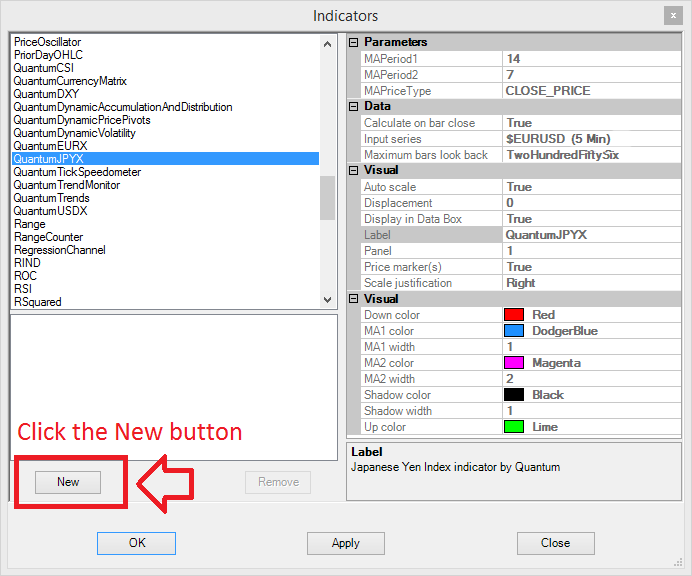
Scroll down to the QuantumJPYX indicator:
- Left click > This will highlight the indicator in blue
- Left click > “New” button as shown above
This will add the QuantumJPYX in the box below as shown here:
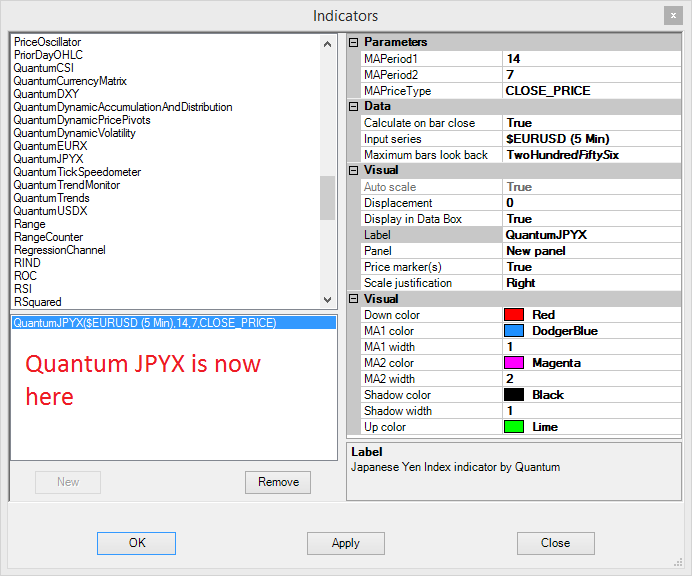
Before clicking the OK or Apply button to complete, the indicator can be configured in several different ways to suit your own personal preferences and trading style. You can click the Apply button at any time, and this will apply any changes you have made to the indicator, without closing the window. This will allow you to see the changes you have made, and to modify again before closing with the OK button, or the Close button.
All of the user configuration is done on the right hand side of the above screen, which is shown enlarged below. These are the default settings when you first install the indicator to a chart.
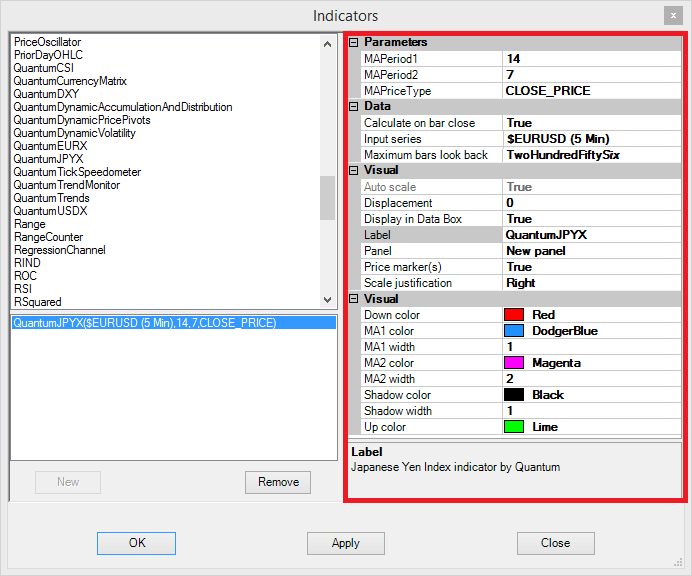
Limitations
Due to the way data is delivered to the platform, the Quantum JPYX indicator is limited to work only in time data series charts namely:
- Second,
- Minute,
- Day,
- Week,
- Month, and
- Year
If for some reason you attach the indicator to a chart other than the above data series, the indicator window will appear blank with a message at the bottom right hand corner as shown below:
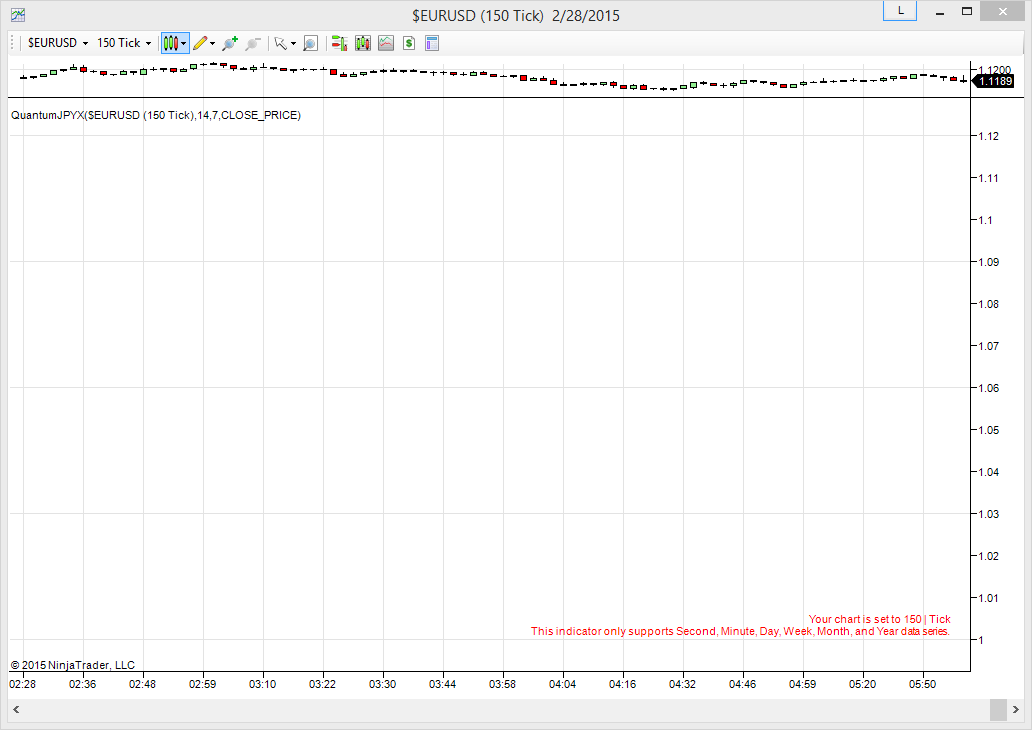
Simply revert back to any of the supported data series mentioned in the message to restore output.
Parameters
These are the Parameters inputs:
MAPeriod1 – This is the period of one of the 2 simple moving averages delivered with the JPYX. It is set to 14 by default and is coloured blue. Though this is the slower moving average of the two, you are free to set this to any other timeframe to suit your own personal preference.
- To change the setting, place your mouse on the MAPeriod1 label, and left click. This will highlight MAPeriod1 in blue. Left click in the value field alongside and your cursor will appear. Delete the value using the back button, and enter a new value.
MAPeriod2 – This is the period of the second simple moving average. It is set to 7 by default and is coloured magenta. Though this is the faster moving average, again you are free to set this to any other timeframe to suit your own personal preference.
- To change the setting, place your mouse on the MAPeriod2 label and left click. This will highlight MAPeriod2 in blue. Left click in the value field alongside and your cursor will appear. Delete the value using the back button, and enter a new value.
MAPriceType – This is the price type from which the 2 guiding moving averages are calculated. You can either choose OPEN_PRICE, HIGH_PRICE, LOW_PRICE, or CLOSE_PRICE. By default it is set to CLOSE_PRICE.
- To change this setting, place your mouse on the MAPriceType label and left click. Notice that a drop down arrow will appear at the right hand side of the value field. Proceed to click it and a list will appear with the four price types. Click one to choose and set.
Data
These are the Data inputs:
Calculate on bar close – Please do not change this setting and leave as the default of true.
Input series – This shows the timeframe for the indicator and will be displayed according to the chart time. In this case the indicator was attached to a 5 minute time chart. (Please note that the Quantum JPYX only works in time charts)
Maximum bars look back – This is the maximum number of bars in the look back for the indicator. We suggest you leave this as the default of TwoHundredFiftySix as it is memory friendly.
Visual
These are the Visual inputs:
Auto Scale – Do not change this setting and leave this as the default of True.
Displacement – Do not change this setting and leave this at the default of 0.
Display in Data Box – We suggest you leave this at the default of True.
Label – This is the label which will display on the chart once the indicator is attached. You can remove this if you wish as follows:
- To remove this, place your mouse on the Label label, and left click. This will highlight Label in blue. Left click in the value field alongside and your cursor will appear. Delete the text using the back button and when you apply the indicator, the text will no longer be displayed.
Panel – this specifies the panel number where the indicator will appear. We suggest you leave this as the default of New panel.
Price Marker(s) – Please do not alter this setting and leave as the default of True.
Scale Justification – Please do not alter this setting and leave as the default of Right.
Plots
This is where you can change the color of the candlesticks as well as the color and width of the 2 moving averages.
Down color – This is the color of the bearish candlesticks. This is set to red by default.
- To change this color, place your mouse on the Down color label and left click. Notice that a drop down arrow will appear at the right hand side of the value field. Proceed to click it and a list of colors will appear under it. Click your desired color to choose and set.
Up color – This is the color of the bullish candlesticks. This is set to lime by default.
- To change this color, place your mouse on the Up color label and left click. Notice that a drop down arrow will appear at the right hand side of the value field. Proceed to click it and a list of colors will appear under it. Click your desired color to choose and set.
Shadow color – This is the color of the candlestick wicks or shadows (showing the high and low). This is set to Black by default.
- To change this color, place you mouse on the Shadow color label and left click. Notice that a drop down arrow will appear at the right hand side of the value field. Proceed to click it and a list of colors will appear under it. Click your desired color to choose and set.
Shadow width – This is the thickness of the candlestick wicks or shadows (showing the high and low). This is set to 1 by default.
- To change this color, place your mouse on the Shadow width label, and left click. This will highlight Shadow width in blue. Left click in the value field alongside and your cursor will appear. Delete the value using the back button, and enter a new value.
MA1 color – This is the color of the simple moving average which is initially the slower MA. This is set to dodger blue by default.
- To change this setting, place your mouse on the MA1 color label and left click. Notice that a drop down arrow will appear at the right hand side of the value field. Proceed to click it and a list of colors will appear under it. Click your desired color to choose and set.
MA1 width – This is the thickness of the first simple moving average. This is set to 1 by default.
- To change this setting, place your mouse on the MA1 width label, and left click. This will highlight MA1 width in blue. Left click in the value field alongside and your cursor will appear. Delete the value using the back button, and enter a new value.
MA2 color – This is the color the second simple moving average which is initially the faster MA. This is set to magenta by default.
- Place your mouse on the MA2 color label and left click. Notice that a drop down arrow will appear at the right hand side of the value field. Proceed to click it and a list of colors will appear under it. Click your desired color to choose and set.
MA2 width – This is the thickness of the second simple moving average. This is set to 2 by default.
- To change this setting, place your mouse on the MA2 width label, and left click. This will highlight the MA2 width in blue. Left click the value field alongside and your cursor will appear. Delete the value using the back button, and enter a new value.
Resizing the indicator
When you first apply the Quantum JPYX indicator to the chart the indicator window may need resizing, and below is an example of how the indicator may look with no option changes applied and the default white background of a NinjaTrader chart.
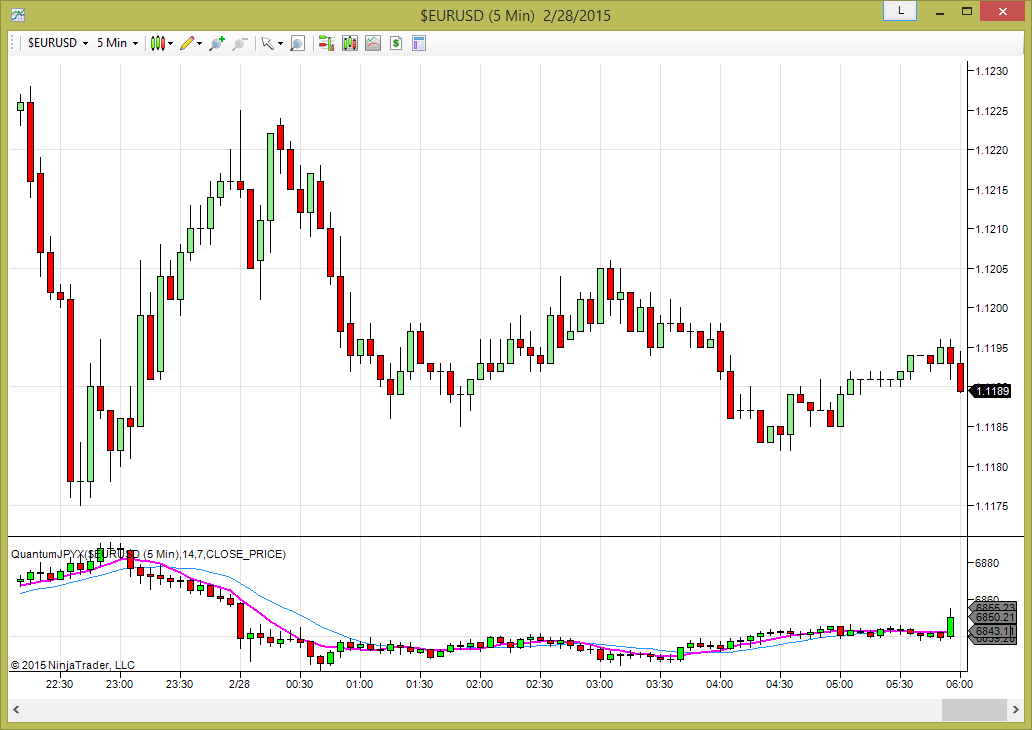
In order to resize the indicator to the maximum height, hover over the horizontal line which separates the chart from the indicator, and you will see a small icon displayed of a solid black line with an arrow above and below. Once this appears, then left click HOLD and drag to resize the indicator window. Your Quantum JPYX indicator will then look like this:

Removing an indicator
These are the steps to remove an indicator from a chart:
Right click on the chart and then left click on Indicators from the pop up menu. Scroll down to the indicator you wish to remove and left click which will turn the indicator blue. This will then display the indicator window with its settings as shown below:
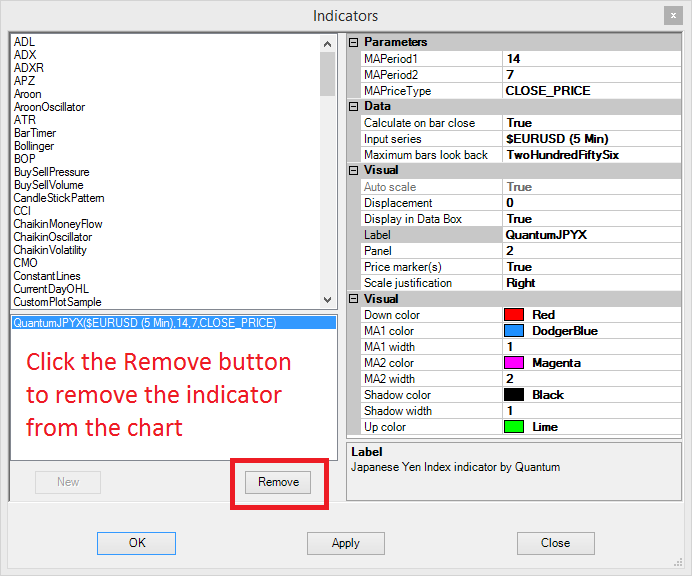
Simply left click on the Remove button as shown above, and the indicator will disappear from the list of indicators on the chart. To confirm left click the OK button to confirm and close the window.



